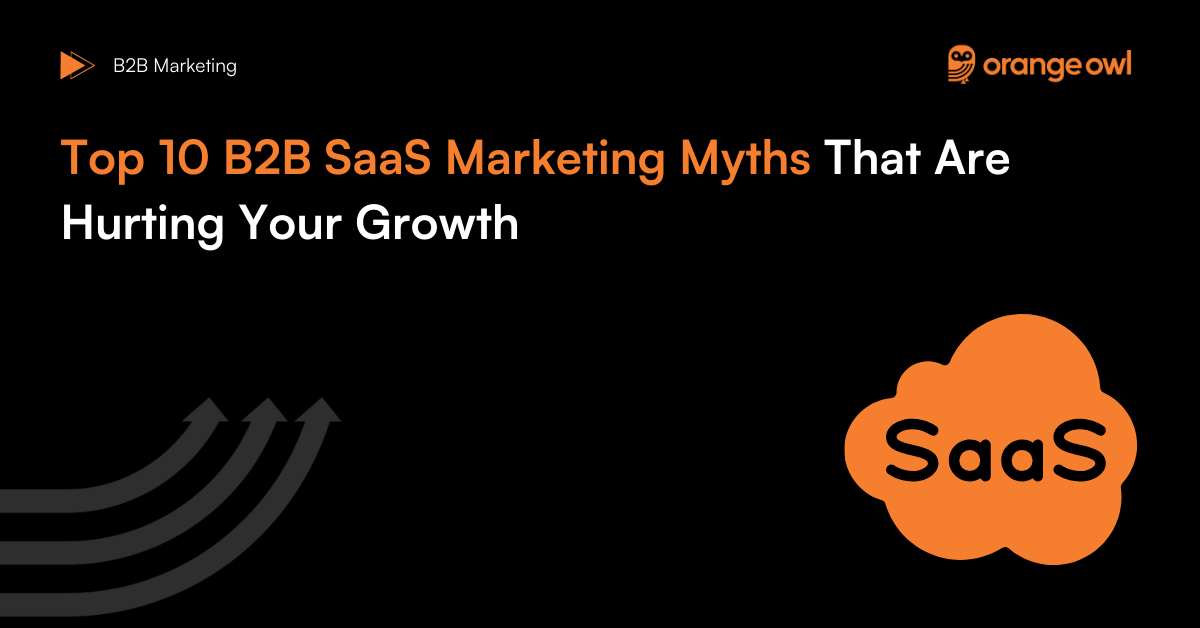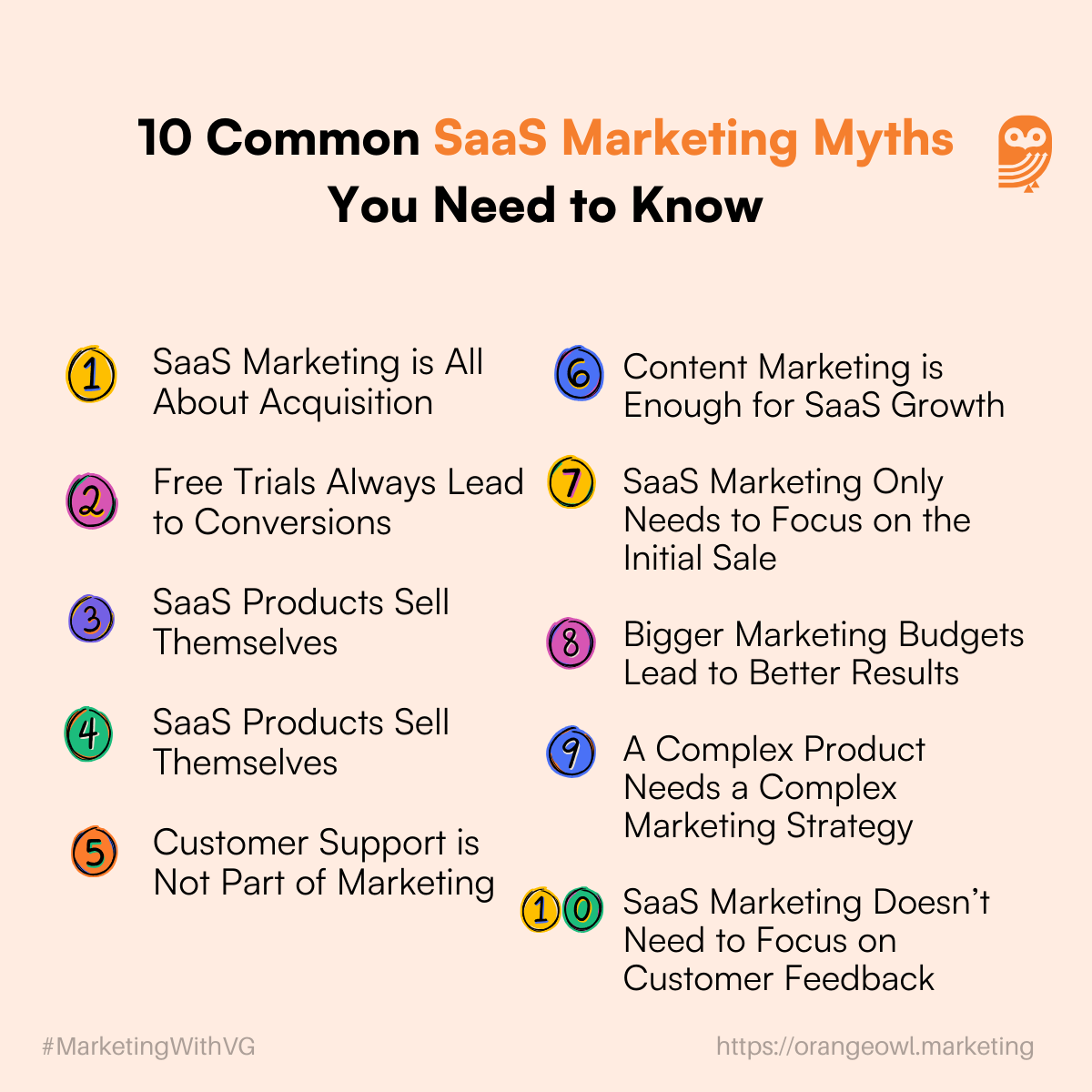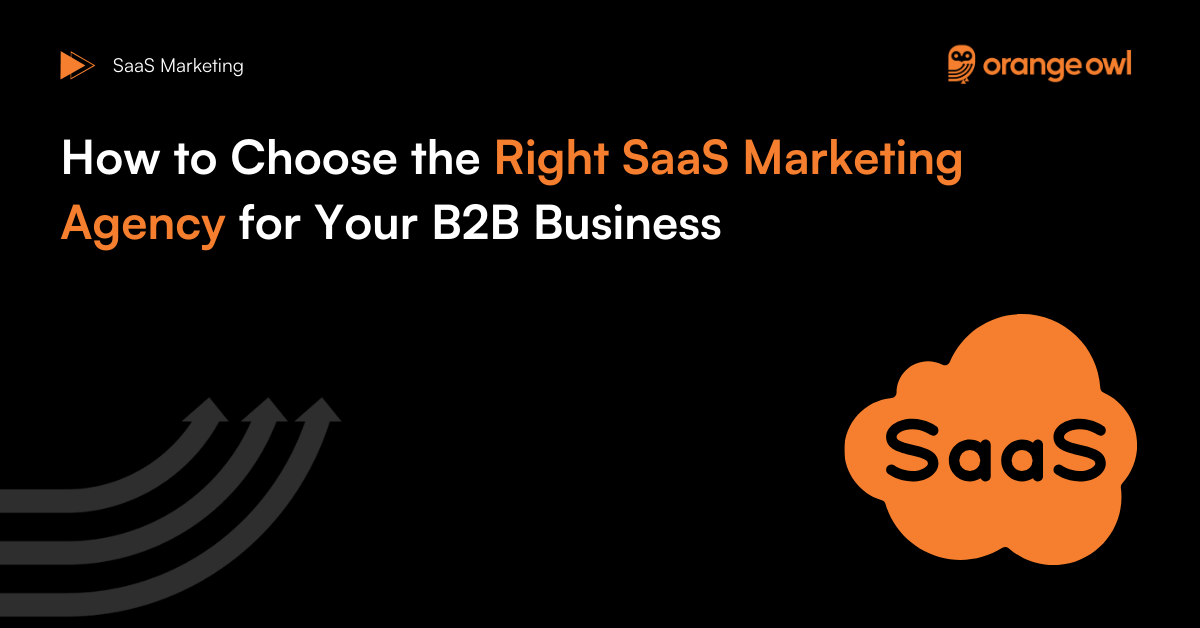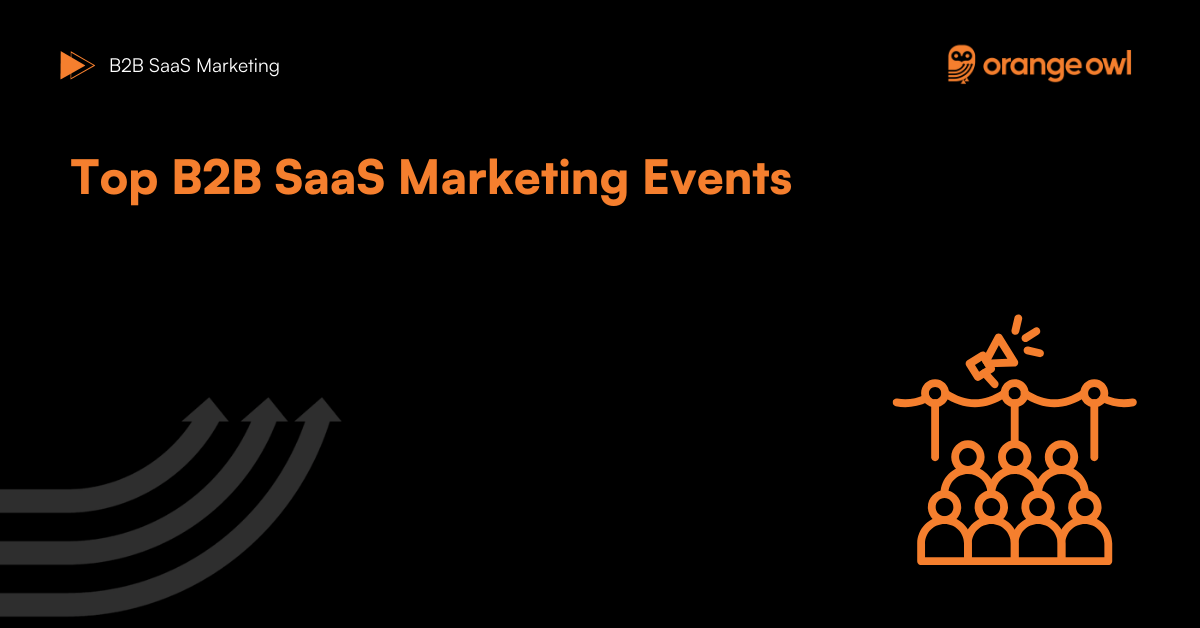Top 10 B2B SaaS Marketing Myths That Are Hurting Your Growth
Vivek Goel
December 13, 2024

Table of Contents
Introduction
The world of Software-as-a-Service (SaaS) is rapidly evolving, with businesses of all sizes embracing cloud-based software solutions to streamline operations and boost efficiency. As the demand for SaaS products grows, so does the complexity of marketing them effectively. However, with the growth of this industry, several myths about SaaS marketing have emerged, often leading businesses down misguided paths.
Many marketers and business owners fall prey to these common misconceptions, which can hinder their ability to craft effective strategies. From overestimating the power of free trials to focusing too heavily on acquisition at the expense of retention, these myths can stunt the potential of a SaaS company’s marketing efforts.
In this blog, we aim to uncover and debunk the most common SaaS marketing myths while providing insights into the truth behind these misconceptions. Whether you’re a seasoned SaaS marketer or just getting started, understanding these myths and the reality behind them will help you create more effective marketing strategies, drive growth, and retain loyal customers. Let’s dive into the most persistent myths and reveal the strategies that truly work in the world of SaaS marketing.
10 Common SaaS Marketing Myths You Need to Know
1. SaaS Marketing is All About Acquisition
Myth: The primary focus of SaaS marketing is to acquire new customers at any cost.
The Truth: While customer acquisition is vital, it’s far from the only priority in a successful SaaS marketing strategy. Retention and expansion play just as critical a role, if not more. In fact, retaining existing customers is often far more cost-effective than constantly acquiring new ones.
The concept of “customer lifetime value” (CLTV) is key here. SaaS businesses that prioritize customer retention often see increased revenue over time, as satisfied customers are more likely to renew subscriptions, upgrade to premium plans, and refer the service to others. Moreover, expanding the existing customer base with upsell and cross-sell opportunities (offering more features, products, or services) can drive significant growth.
Example: Companies like HubSpot and Salesforce don’t just focus on attracting new users—they offer extensive customer education, in-depth onboarding processes, and personalized support to ensure that customers stay happy and continue to find value in their products.
2. Free Trials Always Lead to Conversions
Myth: If you offer a free trial, users will inevitably convert into paying customers once the trial ends.
The Truth: Offering a free trial may increase interest in your product, but it does not guarantee conversion. The success of a free trial depends heavily on the user’s experience during that period. If the onboarding process is difficult, the product lacks perceived value, or if the customer fails to see clear benefits, they are likely to abandon the trial without paying.
To increase conversions, focus on delivering a seamless and engaging trial experience. Offer clear onboarding, in-product guidance, and support during the trial period. Ensure that the product’s value proposition is crystal clear and that users experience immediate benefits.
Example: Dropbox made its mark with an effective free trial strategy. But they didn’t just offer a free trial—they incentivized sharing the service to increase users’ storage capacity. This clever move created both user engagement and word-of-mouth marketing, which resulted in higher conversion rates.

3. SaaS Products Sell Themselves
Myth: A great SaaS product will sell itself without needing a strong marketing strategy.
The Truth: Even the best SaaS products need marketing. While having a top-quality product is essential, product quality alone does not ensure that potential customers will find it. In a competitive market with hundreds or even thousands of similar offerings, a great product needs to be visible to the right audience.
Marketing strategies such as content marketing, paid advertisements, social media outreach, and SEO are crucial in ensuring your product reaches its target audience. Strong customer advocacy, case studies, and reviews can also contribute to your marketing efforts, but these require an initial strategy to get them off the ground.
Example: Slack was an excellent tool from day one, but its marketing efforts—especially its referral program and viral marketing through word-of-mouth—helped the company scale quickly. They understood that even a high-quality product needs a concerted effort to reach a wider audience.
4. SaaS Marketing Is Only for Tech-Savvy Audiences
Myth: SaaS products are designed only for users with advanced technical knowledge, so marketing should target only a tech-savvy audience.
The Truth: Not all SaaS products are intended for technical users. Many SaaS products, such as project management tools, HR software, and marketing automation tools, are designed to be user-friendly for non-technical users. Your marketing strategy should aim at educating potential customers of all levels about how the product can benefit them, regardless of their technical expertise.
The user experience (UX) and interface design of modern SaaS products are often tailored for simplicity, ensuring that even those without technical backgrounds can use them effectively. Therefore, your marketing efforts should emphasize ease of use, practical benefits, and the ability to solve real business problems.
Example: Canva, a graphic design platform, is an excellent example of a SaaS product that targets non-technical users. Its marketing emphasizes how easy it is to create professional-level designs without needing graphic design experience, making it accessible to a broader audience.
5. Customer Support is Not Part of Marketing
Myth: Customer support is just about fixing problems; it’s not part of the marketing strategy.
The Truth: Customer support can be a crucial component of your SaaS marketing strategy. Providing excellent customer support not only helps to retain customers but also plays a role in building trust and loyalty, which can be turned into word-of-mouth marketing.
A happy customer who receives prompt, knowledgeable, and empathetic support is more likely to recommend the service to others. In fact, many SaaS businesses now integrate customer support with their marketing efforts by using support interactions to create case studies, testimonials, or success stories that showcase the value of their product.
Example: Zendesk, a customer support software company, built its reputation on outstanding customer support. By emphasizing this in their marketing, they demonstrate their commitment to helping customers succeed, which enhances their brand image and loyalty.
6. Content Marketing is Enough for SaaS Growth
Myth: Focusing exclusively on content marketing will guarantee success for SaaS products.
The Truth: While content marketing is an essential strategy for educating and engaging potential customers, it should not be the only focus of your SaaS marketing efforts. A comprehensive approach that includes paid media, email campaigns, SEO, webinars, and social media strategies will help you reach a broader audience and drive better results.
Content marketing works best when integrated with other marketing tactics, such as retargeting, lead nurturing, and referral programs. It’s also essential to measure the performance of your content to understand what’s working and optimize for better results.
Example: HubSpot is a leader in content marketing but also uses paid campaigns, email nurturing, and social media to amplify its reach. They integrate all these tactics to create a multi-channel approach that drives SaaS growth.
7. SaaS Marketing Only Needs to Focus on the Initial Sale
Myth: The goal of SaaS marketing is to make a sale and then move on to the next prospect.
The Truth: SaaS marketing should focus on the entire customer lifecycle, not just the initial sale. Retaining customers and ensuring they continue to find value in your product is critical for long-term growth. This requires ongoing communication, education, and support to help customers get the most out of your product.
By nurturing relationships through regular check-ins, offering product updates, and introducing upsell opportunities, you can increase customer lifetime value and reduce churn.
Example: Intercom, a customer messaging platform, focuses heavily on customer relationships by offering personalized, proactive customer support and guidance. This ongoing engagement helps reduce churn and ensures that customers remain satisfied.
8. Bigger Marketing Budgets Lead to Better Results
Myth: SaaS companies with bigger marketing budgets always outperform those with smaller budgets.
The Truth: While a larger marketing budget can certainly help in running more expansive campaigns, it’s not always the budget size that matters—it’s how effectively it’s spent. SaaS companies with smaller budgets can still achieve great results by focusing on highly targeted, data-driven campaigns and leveraging cost-effective tools and platforms.
Smaller companies can gain a competitive edge by being more agile, focusing on niche audiences, and making the most of organic channels, such as content marketing, partnerships, and customer referrals.
Example: Buffer, a social media management tool, grew significantly with a lean marketing budget by focusing on building relationships, offering valuable content, and creating partnerships with influencers.
9. A Complex Product Needs a Complex Marketing Strategy
Myth: If a SaaS product is complex, the marketing strategy must also be complex to explain all its features.
The Truth: Complexity should be avoided in marketing messages, regardless of the complexity of the product. Even highly complex SaaS products should focus on simplifying the core benefits and outcomes that the product delivers. Customers want to understand how the product will solve their problems, not how each individual feature works.
Clear, concise messaging that focuses on pain points and how your product addresses them is more effective than trying to explain every feature.
Example: Salesforce offers an incredibly feature-rich CRM platform, yet its marketing focuses on simplifying the benefits of using Salesforce to improve sales and customer relationships, not overwhelming potential customers with every detail of the product.
10. SaaS Marketing Doesn’t Need to Focus on Customer Feedback
Myth: Once a SaaS product is launched, ongoing customer feedback isn’t necessary.
The Truth: Continuous feedback is critical for SaaS businesses. Regular input from users helps identify pain points, areas for improvement, and new opportunities for growth. A robust feedback loop enables you to enhance your product, improve the user experience, and optimize marketing strategies based on real customer needs.
Listening to customers also creates a sense of trust and loyalty, as users feel valued and heard.
Example: Airbnb consistently gathers feedback from hosts and guests to enhance its platform. They use this feedback to refine both their product and their marketing approach, ensuring they remain competitive in the market.
Conclusion: Demystifying SaaS Marketing for Success
In the fast-paced world of SaaS, understanding the truth behind common marketing myths is crucial for navigating the complexities of customer acquisition, retention, and growth. The myths we’ve debunked in this article highlight the importance of adopting a well-rounded and thoughtful approach to SaaS marketing rather than relying on oversimplified assumptions or outdated strategies.
The key takeaway is that SaaS marketing is not a one-size-fits-all strategy. It requires a delicate balance of acquiring new customers, nurturing existing relationships, providing ongoing support, and continuously gathering feedback to refine the product and marketing tactics. The focus should shift from the misconception of “acquire and forget” to a holistic approach where customer experience, retention, and advocacy play an integral role in growth.
Customer-centricity is at the heart of SaaS marketing. It’s not enough to simply offer a great product; businesses must ensure that customers see clear, immediate value from the start and throughout their entire journey with the product. Whether through seamless onboarding, valuable content, excellent customer support, or regular product updates, all of these factors contribute to a positive customer experience that can translate into long-term success.
Moreover, effective SaaS marketing strategies go beyond just one-off tactics like paid ads or free trials. They require consistency, creativity, and a willingness to iterate and improve based on real-world feedback.
Content marketing, SEO, social media outreach, and customer referrals all play crucial roles in building visibility and credibility in a competitive market, but none of them should be considered as isolated strategies. Instead, they should be integrated into a cohesive, data-driven marketing plan.
Scaling a SaaS business is a process that demands time, effort, and continuous learning. It’s essential to be agile and responsive to changing market conditions, evolving customer needs, and new opportunities. The companies that thrive in the SaaS landscape are those that focus on building meaningful, lasting relationships with their customers and adapting their marketing strategies to align with those relationships.
By dispelling these SaaS marketing myths, companies can better allocate their resources, refine their messaging, and foster stronger connections with their target audience. Ultimately, embracing the truth behind these myths will lead to more efficient marketing efforts, improved customer satisfaction, and long-term success in the highly competitive and ever-changing SaaS industry.
As you implement these insights into your own SaaS marketing strategy, remember that marketing in this space is both an art and a science. It’s about understanding your customers, listening to their feedback, and delivering value consistently at every touchpoint. So, continue to learn, iterate, and adapt. In the world of SaaS marketing, there’s always room for growth, innovation, and improvement.
Frequently Asked Questions(FAQs) on SaaS Marketing Myths
One of the most common myths is that customer acquisition is the only goal in SaaS marketing. While attracting new customers is undoubtedly important, focusing solely on this can lead to neglecting customer retention and satisfaction. In reality, keeping existing customers happy is often more cost-effective and leads to higher lifetime value (LTV). Building a strong relationship with your current customers through consistent communication, updates, and support will help create long-term advocates for your brand, which in turn can drive organic growth.
While free trials are a popular method for encouraging sign-ups, they aren’t a one-size-fits-all solution. A free trial can attract users, but its effectiveness depends heavily on the user experience and how well it is executed. If a SaaS business doesn’t provide a seamless onboarding process, clear instructions, or a value-driven experience during the trial, users might not see the full potential of the product and may not convert to paying customers. Moreover, it’s crucial to have strategies in place, like follow-up emails or personal outreach, to keep users engaged throughout the trial period.
No, even the most innovative and well-designed SaaS product cannot sell itself without a strong marketing strategy. Many products fail to gain traction due to a lack of visibility. In a competitive SaaS landscape, marketing is necessary to build awareness, educate potential users on the product’s value, and differentiate it from competitors. Without marketing efforts, even a great product may remain undiscovered. Effective marketing includes SEO, content marketing, social media presence, and paid campaigns to drive traffic and generate leads.
While SaaS products often have technical features, focusing solely on technical users can limit your market reach. Many businesses use SaaS products for their operational benefits, so marketing should also target non-technical decision-makers, such as business owners, managers, and other stakeholders. The marketing message should emphasize how the product helps solve business problems, increases efficiency, and adds value, rather than just focusing on the technical features. A more holistic approach ensures that the marketing strategy resonates with a broader audience.
Customer support plays a critical role in SaaS businesses beyond just problem resolution. Exceptional customer support fosters trust and customer loyalty, which are crucial for long-term success. By actively engaging with users and resolving issues quickly, you create a positive experience that can turn customers into brand advocates. Furthermore, customer support teams can gather valuable feedback from users, identify common pain points, and relay this information back to product and marketing teams. This feedback loop helps improve the product and shape future marketing strategies.
Content marketing is a powerful tool for attracting and educating potential customers, but it should not be relied on exclusively for driving growth. Content marketing works best when integrated into a larger, multi-channel strategy that includes paid advertising, email campaigns, social media outreach, and influencer partnerships. By leveraging content across various platforms and channels, you can reach a wider audience and nurture leads through the sales funnel. For example, a blog post might attract traffic to your website, but email nurturing and retargeting ads can help convert those visitors into customers.
Focusing only on the initial sale is a short-sighted approach in SaaS marketing. SaaS businesses thrive on recurring revenue, so it’s important to invest in customer retention strategies, upselling, and cross-selling. Building long-term relationships with customers through regular updates, personalized offers, and excellent customer service is key. Additionally, retaining existing customers is often more cost-effective than constantly acquiring new ones, and happy customers can refer others, creating a valuable referral network.
A larger budget can certainly amplify marketing efforts, but it does not guarantee success. How that budget is allocated matters more than the size of the budget itself. Effective marketing is about targeting the right audience with the right message at the right time. A small, well-targeted campaign can often outperform a larger, unfocused one. For example, rather than pouring money into broad paid ads, a SaaS business may achieve better results by investing in highly targeted campaigns, SEO optimization, or influencer partnerships that align with the brand’s values and goals.
A complex SaaS product doesn’t necessarily require a complex marketing strategy. In fact, the most successful marketing strategies simplify the messaging to focus on the core benefits and how the product solves the user’s problems. While the product itself may have intricate technical features, marketing should focus on the value proposition in a way that resonates with the target audience. By using clear, easy-to-understand language, visuals, and case studies, you can help prospects see how the product can make their lives easier, rather than overwhelming them with technical jargon.
Absolutely. Customer feedback is a crucial element in the long-term success of a SaaS product. After a product launch, it’s important to gather feedback to understand how users are interacting with the product, what features they find most useful, and where improvements can be made. This feedback helps shape future product updates, refine marketing messages, and optimize customer support. Additionally, actively listening to your customers and incorporating their input into your product development shows that you value their opinions, which can help build loyalty and trust.
These detailed answers aim to clarify misconceptions and emphasize the broader picture of SaaS marketing, highlighting the importance of customer-centric strategies, effective communication, and integrated marketing efforts.


